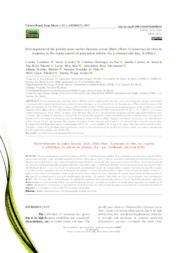Development of the prickly pear cactus Opuntia stricta (Haw.) Haw. (Cactaceae) in vitro in response to the replacement of potassium nitrate for a commercial kno3 fertilizer.
Development of the prickly pear cactus Opuntia stricta (Haw.) Haw. (Cactaceae) in vitro in response to the replacement of potassium nitrate for a commercial kno3 fertilizer.
Autoria: FERREIRA, C. C. de S.; PAZ, C. D. da; SOUZA, J. C. de; PEIXORO, A. R.; RIOS, L. S.; NASCIMENTO, A. R.; RIBEIRO, J. M.; MELO, N. F. de; TEIXEIRA, S. L.; ARAÚJO, J. F.
Resumo: In micropropagation, potassium nitrate (KNO3), an ACS reagent grade chemical, used in the preparation of growing mediums is expensive and its procurement depends on bureaucratic procedures, as it is controlled by the Brazilian Army. This research to assessed the effect of replacing the ACS KNO3 for a commercially available fertilizer (KNO3- based) on the micropropagation of the prickly pear cactus (Opuntia stricta (Haw.) Haw. cv. Elephant Ear. Treatments used six different fertilizer concentrations (0, 0.5, 1, 1.5, 2 and 2.5 g L-1) and a control consisting of 1.9 g L-1 KNO3 , as shown in the MS salts. The survival, size and number of sprouts and the value of fresh biomass were evaluated. After seedling acclimation, we assessed the survival, number of sprouts, length, and number of roots, racket formation, average fresh biomass mass, macronutrient absorption and morphological changes of the seedlings. Explants inoculated with fertilizers at concentrations of 0.0; 2.0 and 2.5 g L-1 did not grow. The response of explants at concentrations of 0.5 and 1.5 g L-1 of the fertilizer were the same as those developed in a KNO3 medium, and at a concentration of 1.0 g L-1, in all variables, the means were higher than those of the control medium. Therefore, it showed the feasibility of using fertilizers in the in vitro cultivation of the prickly pear cactus, which may remove bureaucratic barriers and reduce product costs by 99.12%.
Ano de publicação: 2022
Tipo de publicação: Artigo de periódico
Unidade: Embrapa Semiárido
Palavras-chave: Cultura In Vitro, Macronutriente, Micropropagation, Micropropagação, Opuntia, Opuntia Ficus Indica, Palma Forrageira, Redução de custo
Observações
1 - Por padrão são exibidas publicações dos últimos 20 anos. Para encontrar publicações mais antigas, configure o filtro ano de publicação, colocando o ano a partir do qual você deseja encontrar publicações. O filtro está na coluna da esquerda na busca acima.
2 - Para ler algumas publicações da Embrapa (apenas as que estão em formato ePub), é necessário ter, no celular ou computador, um desses softwares gratuitos. Sistemas Android: Google Play Livros; IOS: iBooks; Windows e Linux: software Calibre.
Acesse outras publicações
Acesse a Base de Dados da Pesquisa Agropecuária (BDPA) para consultar o acervo completo das bibliotecas da Embrapa.

